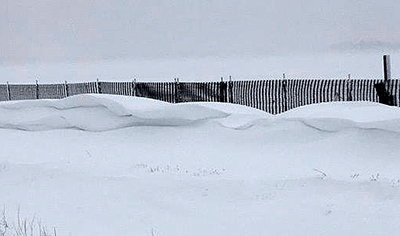By Lynn Clarkowski, Office of Environmental Stewardship director

Lynn Clarkowski, Office of Environmental Stewardship director, encourages employees to read the Earth Week Notemailers to learn more about steps to take that will further MnDOT's stewardship and sustainability. Photo by Rich Kemp |
As people around the world celebrate Earth Week this week, and Earth Day on Sunday, April 22, I’d like to share with you some of the ways that MnDOT works to maximize the health of the environment.
MnDOT is committed in its efforts to maintain, improve and minimize impacts to our state’s resources on an ongoing basis.
Energy efficiency: Since 2011, MnDOT has aggressively worked at reducing energy use in MnDOT buildings across the state. Building operators monitor facility operational trends and can adjust statewide systems remotely. We have implemented new systems, such as door sensors and demand-based temperature control, to achieve energy efficiencies. New MnDOT facilities are built with efficient boilers, furnaces, heaters and LED lighting with occupancy sensors and thermal installations. In 2017, these efforts resulted in energy savings of $400,000.
In addition, employees are replacing outdated equipment with energy-efficient alternatives, such as upgrading shop and pole lights to light-emitting diodes, or LED, fixtures. A total of almost 28,000, or 87 percent, of roadway lights have been replaced with LED lighting.
Improved water quality and reduced chlorides: MnDOT has taken a leadership role in finding ways to meet environmental demands and the public’s need for safe winter driving. During the past 15 years, MnDOT has worked with its partners to develop a winter tool to aid in the most advantageous use of salt and other winter chemicals. The Maintenance Decision Support System, or MDSS, incorporates real-time weather information and road conditions to optimize salt applications during winter storms.
The U.S. Environmental Protection Agency estimates that 40 percent of monitored Minnesota lakes and streams are impaired.
“MnDOT has ongoing efforts to ensure that we’re not putting down more salt than is needed,” according to Barb Loida, Metro District’s Municipal Separate Storm Sewer System (MS4) engineer. “Crews are using alternatives to reduce chloride in lakes and streams.”
“MnDOT works to ensure that proper erosion control measures are being taken statewide so that no sediment-laden water is being released into the surface and ground water,” said Tara Carson, Statewide MS4 permits coordinator, Office of Environmental Stewardship, who works closely with Loida.
Recycled pavement and base materials: Terry Beaudry, pavement engineer, Office of Materials, notes that MnDOT allows for the use of recycled asphalt pavement and recycled concrete aggregate in pavements, as long as these recycled products meet an engineering need.
“In most cases, recycled products perform as well as virgin materials. MnDOT specifications are very permissive in allowing for the substitution of RAP and RCA in many pavement structures,” he said.
The pavement structures range from using 30 percent recycled materials in new bituminous to 100 percent recycled materials in new base and reclamation. This has saved the agency millions of dollars, as well as natural resources, truck traffic and greenhouse gas emissions, without compromising on pavement performance.

Structural snow fences are bring used in MnDOT's blowing snow control efforts in areas that are not conducive to tree or shrub plantings. These fences are typically constructed of wood, metal or plastic. Due to material and labor costs, this type of snow fence is left standing year-round and requires an easement or an agreement with the landowner. Photo courtesy of the Office of Environmental Stewardship |
Employees continuously work to minimize the effects to our natural resources. The Office of Environmental Stewardship and MnDOT’s district staff strive to reduce sediment and other pollutants in highway run-off, implement best practices with prescribed burns to manage native roadside vegetation, manage facility waste from truck stations to ensure it’s being disposed of properly, contain lead paint on bridge refurbishing, install solar-powered traffic devices, control blowing and drifting snow with methods such as living snow fence and standing corn rows, and much, much more on a daily basis.
We encourage you to try carpooling, using transit, or riding a bike to work, plant low-maintenance trees and other vegetation in your yards, try using compost as a natural fertilizer, reduce the use of disposable coffee cups, food containers and silverware, fill up that reusable bottle and use “green driving” practices, like reducing vehicle speed or minimizing aggressive driving.
If we continue to take our earth for granted, and do not take immediate action to protect our resources, it results in significant consequences, such as the Great Pacific Garbage Patch. If we all take some small actions, we can collectively make a large and positive impact on maintaining a clean and healthy earth and workplace.
Thank you for all you do to help protect our environment. |



